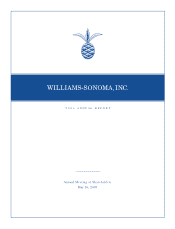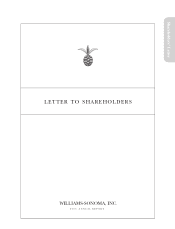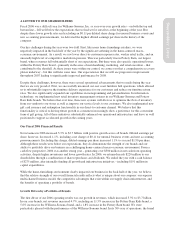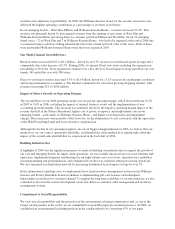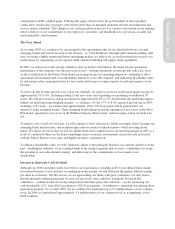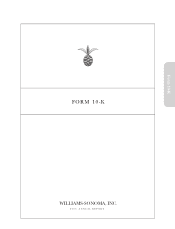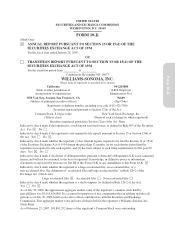Pottery Barn 2006 Annual Report Download - page 6
Download and view the complete annual report
Please find page 6 of the 2006 Pottery Barn annual report below. You can navigate through the pages in the report by either clicking on the pages listed below, or by using the keyword search tool below to find specific information within the annual report.reached a new milestone in profitability. In 2006, the Williams-Sonoma brand, for the second consecutive year,
delivered the highest operating contribution as a percentage of revenues in its history.
In our emerging brands – West Elm, PBteen, and Williams-Sonoma Home – revenues increased 31.4%. This
increase was primarily driven by incremental revenues from the opening of new stores in West Elm and
Williams-Sonoma Home and strong direct-to-customer growth in PBteen and West Elm. Of our 29 emerging
brand stores – 22 in West Elm and 7 in Williams-Sonoma Home – two had to be impaired at the end of 2006 due
to estimated future cash flows falling substantially below the current net book value of the stores. Both of these
were mid-market Williams-Sonoma Home stores that were opened in 2005.
Our Multi-Channel Growth Drivers
Retail revenues increased 6.0% to $2.1 billion – driven by an 8.3% increase in retail leased square footage and a
comparable store sales increase of 0.3%. During 2006, we opened 18 net new stores including the expansion or
remodeling of 28 stores. Store expansions continue to be a key driver of leased square footage growth in our core
brands. We ended the year with 588 stores.
Direct-to-customer revenues increased 4.5% to $1.6 billion, driven by a 3.2% increase in catalog page circulation
and strong momentum in e-commerce. The Internet continued to be our fastest growing shopping channel, with
revenues increasing 21% to $928 million.
Impact of Slower Growth on Operating Margins
The second driver of our 2006 operating results was our pre-tax operating margin, which decreased from 10.2%
in 2005 to 9.6% in 2006, excluding the impact of unusual business events and the implementation of new
accounting pronouncements. This decrease was primarily driven by the negative operating margin impact of the
revenue shortfall in the Pottery Barn brand, higher cost of goods, occupancy and employment costs in our
emerging brands – particularly in Williams-Sonoma Home – and higher asset disposition and impairment
charges. These increases were partially offset, however, by the elimination of costs associated with the operations
of the Hold Everything brand and lower incentive compensation.
Although the decline in our operating margin is one of our biggest disappointments in 2006, we believe that our
intent focus on cost control, operational flexibility, and shareholder value enabled us to significantly offset the
impact of the overall sales shortfall that we experienced in the back half of 2006.
Building Infrastructure
A highlight of 2006 was the significant progress we made in building our infrastructure to support the growth of
our core and emerging brands. In supply chain operations, we successfully insourced our east coast furniture hub
operations, implemented regional warehousing for our high-volume east coast stores, expanded our capabilities
in monogramming and personalization, and reengineered our direct-to-customer returns processing operations.
We also expanded our distribution network by increasing distribution leased square footage by over 7%.
In the information technology area, we implemented new retail inventory management systems in the Williams-
Sonoma and Pottery Barn Kids brands in addition to implementing gift card issuance and redemption
functionality in our direct-to-customer channel. To support the long-term scalability of our infrastructure, we also
continued to invest in the custom development of our new direct-to-customer order management and inventory
management systems.
Commitment to Social Responsibility
We view social responsibility and the protection of the environment as business imperatives and, as one of the
largest catalog mailers in the world, we are committed to responsible paper procurement practices. In 2006, we
established an environmental leadership position in the catalog industry by converting 95% of our paper

